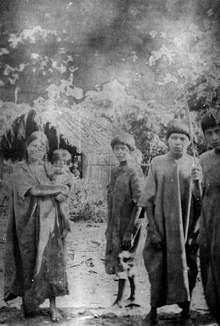Tsimané
The Tsimané, also known as the Tsimane' or Chimane, are an indigenous people of lowland Bolivia, living in the municipalities of San Borja, San Ignacio de Moxos, Rurrenabaque, and Santa Ana de Yacuma of Beni Department.[4] The Tsimané are the main residents of the T’simane Council Territory (Spanish: Territorio del Consejo T’simane) and the Pilón Lajas Reserve. They are primarily a subsistence agriculture culture, although hunting and fishing contribute significantly to many of the settlements' food supply. Those Tsimané living in the Reserve are affiliated with the multiethnic Consejo Regional Tsimane Moseten (CRTM), which holds the title to the Reserve as a Native Community Land or TCO.[5]
 Photo taken in 1913 during Erland Nordenskiöld's expedition in Bolivia | |
| Total population | |
|---|---|
| 16,958[1] | |
| Regions with significant populations | |
| Languages | |
| Tsimané, Spanish[2] | |
| Religion | |
| traditional tribal religion[2] | |
| Related ethnic groups | |
| Mosetén[3] |
Name
The Tsimané are also known as the Achumano, Chamano, Chimane, Chimanis, Chimanisa, Chimnisin, Chumano, Nawazi-Moñtji, and Ramano people.[3]
Language
The Tsimané speak the Tsimané language, which is a Mosetenan language. The other Mosetenan languages are Mosetén of Santa Ana and Mosetén of Covendo (Sakel 2004).[6] It can be described as a small language family, though sometimes it also appears as a language isolate. The reason for this is that some of the variants are mutually intelligible (Sakel 2004), see also [2]
Subsistence
They live in small communities composed of 20 to 30 families. Tsimané and Mosetén people depends mainly on subsistence farming, they cultivate bananas and manioc through swidden agriculture, although hunting, fishing and gathering contribute significantly as a source of food for almost all communities.[7] The population has been undergoing some degree of market integration over the past 15 years, and some Tsimane now participate in the cash economy. [2]
Health
Both the Tsimane' Amazonian Panel Study[8] and The Tsimane Health and Life History Project have studied the Tsimane since 2002.[9] Among other things, it appears that they do not develop heart disease as they age in the same ways as people in the developed world.[10] [11]
The average Tsimané woman has nine children in her lifetime. A study of 983 Tsimané women found that 70% were infected with the parasitic roundworm Ascaris lumbricoides, which is believed to have increased their fertility rate by suppressing their immune system, leading to two additional children over the course of a lifetime.[12]
Slower epigenetic aging rate
Blood tissue from the Tsimané exhibits a slower intrinsic epigenetic aging rate than that of other populations according to a biomarker of tissue age known as epigenetic clock.[13] This finding might explain the "Tsimane inflammation paradox", wherein high levels of inflammation and infection, and low HDL cholesterol levels, are not associated with accelerated cardiovascular aging.[10]
Notes
- "Censo de Población y Vivienda 2012 Bolivia Características de la Población". Instituto Nacional de Estadística, República de Bolivia. p. 29.
- "Tsimané." Ethnologue. Retrieved 22 Feb 2012.
- "Chimane." Countries and Their Cultures. Retrieved 2 March 2012.
- Fundación UNIR (2009). Las identidades en las grandes regiones de Bolivia, Fascículo Nº2. La Paz, Bolivia: Fundación UNIR. pp. 19–20.
- Costas Monje, Patricia (January 1, 2001). "La pluriterritorialidad en el Norte de La Paz. Dos casos de estudio sobre defensa del territorio". In Chumacero, Juan (ed.). Reconfigurando territorios: Reforma agraria, control territorial y gobiernos indígenas en Bolivia. La Paz, Bolivia: Fundación Tierra. pp. 143–44. Check date values in:
|year= / |date= mismatch(help) - Sakel, Jeanette (2004) A grammar of Mosetén. Berlin: Mouton de Gruyter.
- Bottazzi, Patrick (2014) Une écologie politique des territoires tsimane' d'Amazonie bolivienne : notre grande maison. Institut des hautes études internationales et du développement, Genève (Suisse) ; Karthala, Paris.
- "The Tsimane' Amazonian Panel Study".
- "The UNM-UCSB Tsimane Health and Life History Project". Retrieved 2009-08-14.
- Gurven, Michael; Hillard Kaplan; Jeffrey Winking; Daniel Eid Rodriguez; Sarinnapha Vasunilashorn; Jung Ki Kim; Caleb Finch; Eileen Crimmins; Henry Harpending (2009). "Inflammation and Infection Do Not Promote Arterial Aging and Cardiovascular Disease Risk Factors among Lean Horticulturalists". PLoS ONE. 4 (8): e6590. Bibcode:2009PLoSO...4.6590G. doi:10.1371/journal.pone.0006590. PMC 2722089. PMID 19668697. Retrieved 2009-08-14.
- "Age Doesn't Mean Heart Disease For Bolivian Tribe". NPR. Retrieved 2009-08-14. Missing or empty
|series=(help) - Gallagher, James. "Parasitic worm 'increases' women's fertility'". BBC.com. BBC. Retrieved 20 November 2015.
- Horvath S, Gurven M, Levine ME, Trumble BC, Kaplan H, Allayee H, Ritz BR, Chen B, Lu AT, Rickabaugh TM, Jamieson BD, Sun D, Li S, Chen W, Quintana-Murci L, Fagny M, Kobor MS, Tsao PS, Reiner AP, Edlefsen KL, Absher D, Assimes TL (2016). "An epigenetic clock analysis of race/ethnicity, sex, and coronary heart disease". Genome Biol. 17 (1): 171. doi:10.1186/s13059-016-1030-0. PMC 4980791. PMID 27511193.
External links
- Tsimané material culture, National Museum of the American Indian
- Tsimane Amazonian Panel Study
- The Tsimane Health and Life History Project
- Pueblos Indíginas de Bolivia: Chiman (in Spanish)
- https://www.sciencedaily.com/releases/2017/03/170317132004.htm